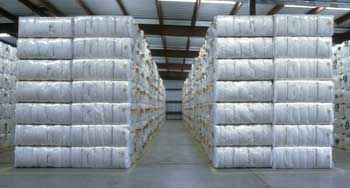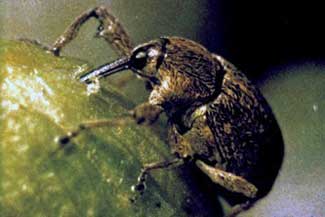National Cotton Council staff worked in several regulatory arenas to ensure the U.S. cotton industry was not burdened with rules or denied access to products that would compromise its ability to compete in the world marketplace.
 |
Densely packed baled cotton is no longer listed as a high hazard – and avoided severe requirements - after NCC-proposed changes to the International Code Council’s Fire Code were approved. |
Densely packed baled cotton is no longer listed as a high hazard – and avoided severe requirements - after NCC-proposed changes to the International Code Council’s (ICC) Fire Code were approved. Texas warehouseman Bob Weatherford and NCC staff testified and presented sound science for not considering densely packed cotton bales as a flammable hazard. The ICC also adopted a NCC-supported change that ruled that cotton ginning, as an extension of the harvest, is an agricultural process, not a commercial or industrial operation.
American Cotton Producers member Charles Parker of Missouri joined other commodity representatives in stressing to EPA Deputy Administrator Marcus Peacock the importance of retaining important crop protection products. Those included cotton biotech products and malathion, necessary for the weevil eradication program, and aldicarb, needed for nematode and thrips control.
The Joint Cotton Industry Bale Packaging Committee agreed to develop a strategic plan for the industry’s bale packaging program, including the need to move toward a “Uniform Certification Program.”
NCC staff provided USDA’s Animal & Plant Health Inspection Service an orientation on cotton bale phytosanitary issues. The NCC’s Phytosanitary Accreditation Protocol Task Force, chaired by North Carolina warehouseman Coalter Paxton, III, developed a national compliance agreement aimed at minimizing the risk of plant pest/disease transfer during cotton shipment.
The NCC’s Quality Task Force, meeting in early 2006, agreed that international adoption of instrument standards similar to the U.S. instrument-based classing system will be in the best interest of both U.S. cotton and world textile mills. That panel also sanctioned NCC’s activities to continue communicating to industry the importance of sticky cotton prevention and of moisture management in cotton bales.
The NCC distributed compact discs of its “Prevent Lint Contamination” slide presentation to certified interest organizations as part of an ongoing NCC contamination prevention campaign as sanctioned by NCC delegates and the Joint Cotton Industry Bale Packaging Committee.
The NCC submitted recommendations in support of several USDA Agricultural Research Service cotton projects for 2006: aflatoxin control, including the use of bio-control product AF-36 in Arizona and South Texas; cotton genomics and biotechnology research to improve crops, irrigation cropping systems in the Mid-South and resistance management and risk assessment in Bt cotton and other plant protection products; the National Germplasm Resources Program; cotton genetics for improving yield and fiber quality; plant stress and conservation; ginning research; pathology of Fusarium diseases; textile research to determine physical, biological and chemical analyses to explain variations in processing efficiency and end quality; genetic resistance to nematodes; and biological control research for cotton pests. Funding also was sought for regional research and education on reniform nematode for Mid-South states.
 |
| Protecting U.S. cotton producers’ eradication investment has become a major focus of the NCC’s Boll Weevil Action Committee. |
Phase I of the Pink Bollworm Eradication Program – in West Texas, south central New Mexico and Chihuahua - made excellent progress with its sterile moth release effort. As a result of the program receiving $5.22 million in federal funds for FY06, the NCC’s Pink Bollworm Action Committee finalized plans to initiate Phase II – western New Mexico and eastern and central Arizona - of the three-phase program during 2006. An oversight committee was set up to coordinate with USDA-APHIS on the pink bollworm sterile moth rearing facility in Phoenix and on eradication programs in the San Joaquin Valley, Arizona, New Mexico, Texas and Mexico.
In other key 2005 activities, the NCC:
- Asked the Consumer Products Safety Commission to: 1) not regulate mattresses indirectly by regulating bedclothes, 2) work closely in an open and transparent way with California in the development of any standard to address the flammability of bedclothes and 3) make smolder resistance (cigarette ignition), not open flame, the focus of flammability standards for upholstered furniture;
- Asked EPA to amend oil spill prevention and response plans to consider the cotton gin bale press as oil-filled operational equipment not oil storage, to raise the tank threshold for coverage to at least 10,000 gallons instead of 1,320 gallons, and to regulate vegetable oil different from petroleum oil;
- Served as a cooperator for the National Cotton Ginners Association’s 2005 Ginner School;
- Supported a bill to update and reform the Endangered Species Act;
- Joined other agricultural groups in urging Senate approval of Steven Johnson as EPA administrator;
- Urged EPA not to promulgate a coarse particulate matter standard unless or until research justified a health-based standard and adequate sampler technology is available; and
- Joined with other agricultural groups in urging the Senate to reject an amendment to the 2006 EPA and Interior appropriations bill that would prevent EPA from considering data from human studies when establishing pesticide tolerances.

